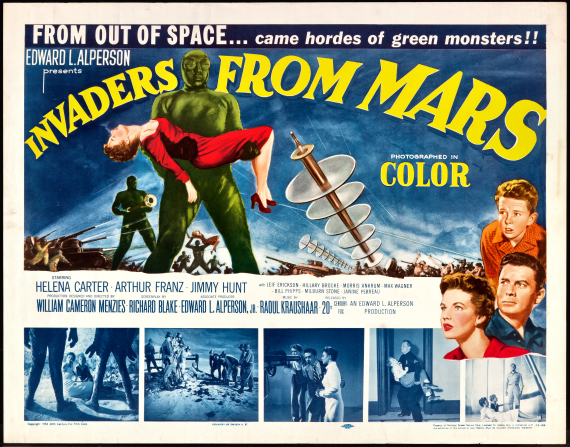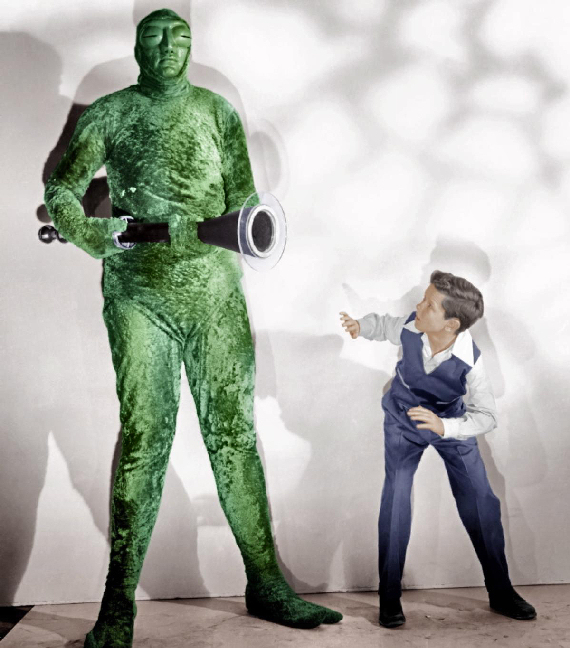
We’re spending a lot of time and money to explore—and perhaps, soon, colonize—the planet Mars; but something nobody in NASA seems to have asked is “Should we?” Given the filmatic evidence, the planet might be someplace we Earthlings should stay away from. To that end (“Submitted,” as Rod Serling used to say, “for your approval”) I offer these two movie reviews. I hope you take this column seriously; perhaps it’s time to reevaluate our upcoming Arean missions! (“Ares,” as most people know, is the Greek word for Mars.) By the way, since these movies are both over half a century old, I will not shy away from spoilers; they are both readily available on the internet. (I can’t guarantee that the ones I post links to will be there tomorrow; movies on the internet tend to disappear a lot, even the public-domain ones. And I’m not sure whether these are actually public domain.*)

First on our list is The Angry Red Planet. Right off the bat, there’s an oddity—the title of the movie doesn’t appear until the end of the movie. Not typical for SF of that period, I think. (By the way, the “science” of this movie isn’t exactly rigourous, but it’s still an SF movie, as it uses extrapolation of known science, rather than fantasy. Okay, they don’t know much about science, but they’re trying, darn it!) Another oddity is the poster (Figure 2), which gives away practically every special effect in the movie. You’d think they’d hold something back. Oh, well. The movie is filmed in something called “Cinemagic,” which is Hollywood-speak for “Hey, the whole screen’s been overlaid with a really red filter so you won’t notice that there’s a bunch of matte paintings,” but it really doesn’t work because you can tell really easily what’s live and what’s matte. According to Sid Pink (via Wikipedia), the co-writer/producer, “The damn Cinemagic didn’t work like it should. It was supposed to be sort of a 3-D effect. What we came up with was great anyway!” Well, his interpretation of “great” probably isn’t mine. However, these are minor quibbles: the whole movie (again, according to Wikipedia) was shot in ten days on a budget of $200K; take that, George Lucas!
Quick run-through on the plot. Four people—an Air Force colonel Thomas O’Bannion (Gerald Mohr); Dr. Iris Ryan, a “foremost” female biologist (Naura Hayden); Dr. Theodore Gettell, a professor and world-renowned geologist (Les Tremayne); and Sam Jacobs, an Air Force Chief Warrant Officer (Jack Kruschen) are selected to crew the MR-1, or Mars Rocket One. They will fly to Mars, spend five days there and fly home. Unfortunately, Earth loses contact with MR-1 shortly after they land, until the Palomar Observatory finds the ship apparently drifting in orbit around Mars. The Air Force decides to remotely trigger the return rockets, and the ship lands safely, but there are only two survivors, Dr. Ryan and Col. O’Bannion, and there is a strange green substance on Col. O’Bannion’s arm. They are both taken to hospital, and Dr. Ryan appears to be suffering from some form of hysterical amnesia (perhaps triggered by a shock on Mars), but they need her to remember what happened so they can try to treat O’Bannion. They have checked nearly all the ship’s tapes, and so far, they’ve been blank, as if they’ve been erased by a strong magnetic field. The doctors decide to give Iris drugs to get past the memory block, and she begins to remember. (From this point, we view the crew on Mars as if we were there.)

After they land on Mars, the four of them begin to explore—this is where the “Cinemagic” cuts in (all daylight scenes on Mars are “Cinemagic,” i.e., red). Iris (who is a Doctor of Biology, remember) sees a three-eyed Martian looking at her through the porthole and screams her red head off… but nobody believes her. (Silly woman!) Anyway, they go out to explore and Iris is attacked by a giant Venus Flytrap with tentacles (Figure 1). Fortunately, the people on Earth have foresightedly included a machete with the supplies; and O’Bannion is carrying that as well as the pistol he and the others are wearing. (This is just after Ryan says she’s a scientist and won’t react like a typical woman if attacked.) Tom O’Bannion cuts her free and they go back to the ship. O’Bannion says that this won’t deter them; they will stay the allotted five days. By the way, during the trip, which is supposed to take 29 days (according to O’Bannion, I think), Sam says the radio lag is only a couple of seconds but it will be a real pain when it’s a couple of hours. But the actual lag time when Earth and Mars are farthest apart is about 24 minutes. Well, at least they tried for a bit of science here!

Anyhow, they go out the next day and find the 40-foot-tall creature in Figures 2 and 4, the “bat-rat-spider,” according to Sam. Dr. Gettell almost gets squished by its claw (the actual “monster” is kind of a neat marionette), and Sam has to shoot its eyes with his freeze ray gun (affectionately called “Cleo,” from Cleopatra, “because she’s a doll”) and they go back to the ship.This time O’Bannion says they’re leaving, but they discover they can’t. An unknown force is holding the ship in place. (Perhaps directed, Iris says in all seriousness, by a sort of super-intelligent “hive mind.”) At some point in this, they find a lake, thus proving there is water on Mars. Fortunately, the Earth guys packed an inflatable boat, so they set out to see what’s on the other side, just over the horizon (Mars is smaller, right?). Halfway there they see a giant city (“How tall are those towers, Doc?” “Why, they must be half a mile tall!”), but before they can get to it, they’re attacked by a giant amoeba with a spinning eyeball (though it doesn’t look like any amoeba I’ve ever seen), and chased back to the ship. When they get to the ship, Sam is captured by an amoebic tentacle and sucked into the amoeba and consumed. (A pretty good effect for the time.) And here’s where O’Bannion was touched by the amoeba and infected; now—back on Earth—the doctors have the information they need (“It’s an enzymatic infection!”) to cure him. The mysterious force that was holding them releases them, so they trigger the automatic takeoff. Dr. Gettell doesn’t survive; he has an apparent heart attack and dies during takeoff. Back on Earth, the Air Force discovers that the very last tape has a message on it, which is essentially, “People of Earth, you suck. We of Mars don’t want you here, and if you try to come back we’ll fix your little red wagon, so stay away.” Iris and O’Bannion recover and we go to the title.
When I first (or maybe last) saw this movie, on TV, it was in black and white (we didn’t have colour TV in our house) and I thought it was dreadful. But seeing it for the first time the way it was seen in the theatre, and many years later, I’m not so sure it was a bad movie for the time (IMDB and other sources list it as 1959, but the movie itself has a copyright date on it of 1960); sure, it sucks scientifically—but then, how much did we really know about Mars back then? Things that don’t add up include: they know there’s not enough oxygen on Mars, but their helmets don’t seem to have face plates; they don’t experience zero-gee because Tom (O’Bannion) turns on the “one-gee rocket” for the trip; and they have a giant vacuum-tube computer that makes up the whole back wall, which they apparently don’t use. (Burroughs provided it, as the Air Force provided the ejection seats and high-altitude gear that were used in the film as “space suits.”) Unusual for the time, there’s no actual smoking in this film, I noticed, which is a plus, but the “chauvinist” attitude—hotshot male Air Force officer makes play for red-headed female scientist bombshell; she “gets the chow” for the guys and has screaming and fainting spells; the guys watch with amused tolerance when she takes a break from her scientific work (just what is she doing with that screwdriver and pliers/wire cutters, anyway?) to put on some scent, etc.—hoo boy! However, I found it faintly charming, in fact, as an example of SF movies of the time.
I just hope we take heed of the Martians’ warning and stop sending rovers and the like to Mars before it’s too late!

Our second film, Invaders From Mars, is one I didn’t catch on its first release (partly because I was only 6 at the time, and partly because we were in England); I first saw it when I was about 8. We were living in Yuma, Arizona and my school had free movies at summer school, in between bouts of making potholders from loops and “Indian” beadwork belts and the like. As I say, I was about 8 (this was 1955), and the movie scared me spitless. Now, I was no stranger to SF; I’d been reading it for a couple of years, but these images were much stronger than the ones I’d cobbled up in my mind at the time. (And the Martians’ habit of making things vanish down “funnels” in the sand reminded me of the ant-lions we used to catch in Arizona, too.) It’s not a great movie, but it was directed by William Cameron Menzies who, as you probably know, is famous in our genre for directing Things To Come (1936), from the H.G. Wells screenplay. This is also a full-colour movie—with no trace of “Cinemagic”—at no time does the whole screen turn red; the acting is at least competent, and the special effects are—well, okay for 1953. (You will probably remember that this is also the year of George Pal’s War of the Worlds, so this one kind of suffers by comparison.) Now, don’t confuse this with the (sorry, Tobe) inferior Tobe Hooper remake of 1986. Here’s the plot.

Young David MacLean (Jimmy Hunt), an amateur astronomer, is awakened around 4 a.m. by a violent thunderstorm and, going to his window (Figure 6), sees a spaceship landing in the sand pit behind his house. Excited and frightened, David runs to wake his parents, but they tell him it’s a dream and put him back to bed, promising to take him out tomorrow to show him there’s no spaceship back there. David’s father George (Leif Erickson) then puts on his robe to go check, telling his wife Mary (Hillary Brooke) that because of his high-security work at “the plant,” he has to check out anything that might be a security risk, including this. We see (but his family doesn’t) George walk up the hill in his bathrobe; we see a funnel-shaped vortex appear in the sand and George disappears, then the sand fills back up to level. And for some reason a choir begins to swell as George walks up the hill, then abruptly stops when George disappears. Morning comes and George isn’t home yet; worried, Mary calls the cops. Two cops comes and agree reluctantly to investigate (silly woman!). As they approach the hill by the fence leading up to the sand pit, the choir swells and one, then the other, cop disappears. Meanwhile, George has returned home, telling Mary brusquely that he was visiting a neighbour. He is cold and sullen, even hitting David when David asks too many questions (we sense this is the first time he has ever hit David). David notices a strange red mark on the back of his neck. Back at his room, David sees Kathy, through his telescope, a neighbour girl, disappearing at the sand pit. He runs to her house to tell her mother, but Kathy suddenly appears, giving the lie to his tale. Kathy has taken a can of gasoline from the garage and thrown it in the basement of her parents’ house, setting it on fire. Leaving the neighbours to deal with the fire, David runs downtown to the police station to report these goings-on. He wants to speak to the police chief—and the chief is cold and unsympathetic; we and David see a red “x” on the back of his neck. The chief tells the desk sergeant to lock David up and call his parents. Health Department psychologist Dr. Pat Blake (Helena Carter) is called in to deal with David, but he convinces her there’s something wrong; when his parents appear, she refuses to let them take him, telling them he has an infectious disease and must be hospitalized.

David’s old astronomer friend from the local observatory, Dr. Stuart Kelston (Arthur Franz) soon enters the picture, and he and Dr. Blake realize the flying saucer probably heralds an invasion from the planet Mars, now in close orbital proximity to Earth. Dr. Kelston contacts the U. S. Army (an important government rocket research plant is located nearby, and Kelston has all kinds of code words), which sends Colonel Fielding (Morris Ankrum). Fielding orders all kinds of troops and tanks to surround the pit just in time, because a sabotage attempt is made on the plant. Kathy, the little Wilson girl, has dropped dead of a brain aneurysm, as did the two saboteurs. Dr. Kelston theorizes that Martians are more evolved than humans and probably live underground on Mars, utilizing clones, called mutants (pronounced “mew’-tants,” rhymes with “you ants”) to do their work.Col. Fielding, aided by Capt. Roth (Milburn Stone, remember him? He played “Doc” on Gunsmoke later), attempt to dig out the last place in the pit where people have disappeared; they succeed in finding a tunnel, but it’s a dead end.

Kelston theorizes that the Martians have an “infrared ray” that can dig tunnels in an instant (we actually see the mutants using this; first the wall they focus on glows red and bubbles, then explodes. Voila! Instant tunnel!). Kelston, meanwhile, has done an autopsy on Kathy and discovered a little crystal diode thingy in her brainstem; he and Dr. Blake theorize this is how the Martian is controlling people. He builds a detector based on the crystal and they begin trying to find the spaceship underground. Meanwhile, the mutants manage to tunnel under Dr. Blake and David, who are captured while trying to figure out what that choral noise is. (Finally, someone noticed it besides us!) Anyway, there is a big battle underground involving the Army, mutants, David, and Doctors Kelston and Blake, and the Army plants explosives in the Martian’s ship; the whole group manages to capture an infrared raygun (Figure 9) and escape just before the Martian ship blows up. (Oddly enough, they leave the gun in the tunnel as they escape. Me, I would have taken it with me!) There is a long running sequence, where David is seen running away from the coming explosion, while scenes from everything we’ve seen before play in the background.

There is a large explosion, and David wakes up in his bed, with thunder and lightning outside. He runs into his parents’ bedroom and is surprised to see them home and well… he tells them of his experience, and they assure him that none of it happened; he was just dreaming! They put him back to bed… and shortly thereafter, he sees, out of his window, a spaceship, landing in the sand pit! It sounds corny as heck, but after watching it again, I think it was quite effective. And if the actors all look familiar, it’s because most of them appeared in more than one SF/F film of the ‘50s or ‘60s. By the way, the two main female stars make it appear that there’s an SF “type” of actress. I might have to explore this. At the very least, it gives me an excuse to watch more old SF movies! (By the way, does anyone else see here a parallel with Jack Finney’s Invasion of the Body Snatchers?)
Now, if this movie, combined with the first movie, doesn’t convince the powers-that-be to stay the heck away from Mars, I don’t know what will! (And I haven’t even mentioned movies like The Martian Chronicles, Mars Attacks or Santa Claus vs. The Martians!) What will it take to get us to stay “raht cheer on Ma Earth whar we b’long”? Sigh.
LAST WORDS: Fellow Canadians, voting on the Aurora Awards began yesterday. I urge you to pay your $10 if you haven’t already, to join CSFFA (the Canadian SF/F Association) and vote for the best of the year. That $10 will get you something like a couple of hundred dollars in ebooks, etc., so it’s well worth it! And if you like this column and the job I’m doing here at Amazing Stories Online, I’d appreciate a vote for me in the Fan (Other) category!
*According to Wikipedia, Invaders From Mars is definitely not public domain, so grab the chance to see it while you can. You can occasionally find copies on DVD at Wally-Mart and other retailers, however, for under $10.
Don’t forget to drop me a comment on this week’s column. If you haven’t already registered—it’s free, and just takes a moment—you can register and leave a comment here. Or you can comment on my Facebook page, or in the several Facebook groups where I publish a link to this column. You don’t have to agree with me to post a comment—corrections, differences of opinion, whatever; I’d love to hear from you. My opinion is, as always, my own, and doesn’t necessarily reflect the views of Amazing Stories or its owners, editors, publishers or other columnists. Or even my wife’s. See you next week!











1 Comment